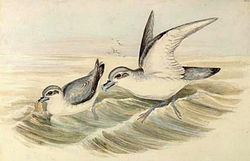PTRS168 0617
Autor/Urheber:
Scan by the Internet Archive
Shortlink:
Quelle:
Größe:
2445 x 3274 Pixel (1040959 Bytes)
Beschreibung:
- Stercorarius antarcticus Lesson = Stercorarius antarcticus lonnbergi
- Stercorarius catarractes L. = Stercorarius skua Brünnich, 1764
- Adult female Prion vittatus Lacep. = Pachyptila vittata (Forster, 1777), bill from above
- Young male Prion vittatus Lacep. = Pachyptila vittata (Forster, 1777), bill from above
- Adult male Prion vittatus Lacep. = Pachyptila vittata (Forster, 1777), bill from above
- Old male Prion vittatus Lacep. = Pachyptila vittata (Forster, 1777), bill from above
- Young male(?) Prion banksii Smith = Pachyptila desolata banksi Smith, 1849, bill from above
- Young male(?) Prion brevirostris Gould =? Pachyptila turtur (Kuhl, 1820), bill from above
- Old(?) male Prion desolatus Gm. = Pachyptila desolata desolata (Gmelin 1789), bill from above
- Female Prion desolatus Gm. = Pachyptila desolata desolata (Gmelin 1789), bill from above
Kommentar zur Lizenz:
Author died more than 70 years ago - public domain
Lizenz:
Public domain
Credit:
Philosophical Transactions of the Royal Society 168: An Account of the Petrological, Botanical, and Zoological Collections Made in Kerguelen's Land and Rodriguez During the Transit of Venus Expedition Carried Out by Order of Her Majesty's Government in the Years 1871-1875 (Plate VII)
Relevante Bilder
Relevante Artikel
WalvögelDie Walvögel (Pachyptila), auch „Entensturmvögel“, „Eisvögel“ oder „Feuervögel“ genannt, sind eine Gattung der Familie der Sturmvögel (Procellariidae), die ihr Verbreitungsgebiet in den antarktischen Gewässern haben. Mit einer Körperlänge von 25,4 bis 28 cm und einer Flügelspanne von 40,7 bis 45,7 cm zählen sie zu den eher kleinen Vertretern dieser Familie. Sie unterscheiden sich von den anderen Sturmvögeln durch ihr unauffälliges Federkleid und ihren Schnabel sowie durch ihre Flug- und Nahrungsweise. .. weiterlesen

